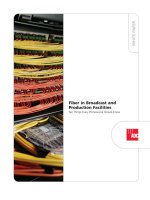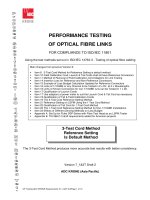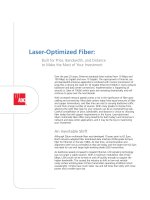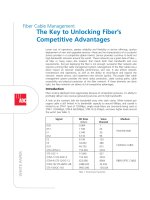Tài liệu ADC KRONE - Guide - EDF - Centralized Cross-Connection for managing Ethernet Data Services doc
Bạn đang xem bản rút gọn của tài liệu. Xem và tải ngay bản đầy đủ của tài liệu tại đây (475.64 KB, 4 trang )
Situation
Ethernet-based data services offer the opportunity to create differentiation, command premium
pricing, and earn higher margin for such value-added data services as transparent LANs, storage
area networks, and virtual private networks. Extending native 10/100Base-T and Gigabit Ethernet
services across the LAN, WAN, and MAN means data services are less expensive to deploy,
provision quickly, and offer exceptional reliability and security. Yet as the Ethernet distribution
system grows with more routers and switches in central offices, all of these advantages can be
quickly erased by a poorly designed cabling and connectivity architecture.
As service providers move from being vendors of T1, T3 and OC-XX data pipes to partners
providing value-added Ethernet data services, an effective business model includes the following goals:
• Create a flexible, carrier-class Ethernet delivery system, and
• Decrease operating costs of Ethernet delivery.
Reaching these goals is contingent largely upon building the correct architecture to support
Ethernet data services.
Solution
Achieving the dual requirements of lower costs and carrier-class services is possible by creating a
centralized cross-connect patching system with an Ethernet Distribution Frame (EDF). An EDF
provides a cross-connect field that ties together all Ethernet network elements from multiple floors
of the central office (CO) or point-of-presence (POP), providing a common craft interface for
performing adds, upgrades, and rearrangements on Ethernet services. In this simplified
architecture, all network elements have permanent equipment cable connections that are, once
terminated, never handled again. Technicians isolate elements, connect new elements, route
around problems, and perform maintenance and other functions using semi-permanent patch
cord connections on the front of the EDF cross-connect bay. This craft-friendly design supports
cost-effective growth and change in the Ethernet distribution system.
Ethernet Distribution Frame
Centralized Cross-Connect System for
Managing Ethernet Data Services
application note
Figure 1
Active Network
Element Bays
Ethernet
Distribution Frame
Active Network
Element Bays
2/03 • 1257483
Ethernet Distribution Frame
Ethernet Distribution Frame
2
www.adc.com • +1-952-938-8080 • 1-800-366-3891
Benefits
• Lower operating costs. As compared to direct connect or interconnect designs, the EDF cross-
connect reduces the time it takes for adding cards, moving circuits, upgrading software, and
performing maintenance. Factory assembled cable assemblies and patch panels reduce installation time
and ensure consistent quality. In addition, this high-density interface for Ethernet distribution not only
maximizes active ports but also conserves valuable floor space.
• Improved reliability and availability. Permanent connections protect equipment cables from daily
activity that can damage cables. Moves, adds, and changes are effected on the patching field instead
of on the backplanes of sensitive routing and switching equipment, enabling changes in the network
without disrupting service. With the ability to isolate network segments for troubleshooting and
reroute circuits through simple patching, Operations gains time for making proper repairs during
regular hours instead of during night or weekend shifts.
• Competitive advantage. The EDF enables rapid changes to the network. Turning-up new service is
accomplished by plugging in a patch cord instead of the labor-intensive task of making multiple hard-wired
cable connections. As a result, cards are added to the network in minutes instead of hours, decreasing
time to revenue and providing a competitive edge—faster service availability—in the marketplace.
• Investment protection. Unlike direct connection of Ethernet elements, the logical EDF cross-connect
scales easily. As elements are added, transport methods changed, and new technologies implemented,
the EDF remains constant, providing the common craft interface for managing Ethernet distribution
without service disruption.
Implementation
Creating a craft-friendly, low-cost Ethernet
distribution system fully rated for Gigabit
Ethernet consists of the following products:
Ethernet Distribution Frame, providing
the central location for cross-connecting all
Ethernet network elements in a CO or POP
with semi-permanent connections. Each EDF
consists of the following ADC equipment:
• 19" UEF zone 4 rack
• Glide Cable Management system,
consisting of vertical cable managers
installed on the sides each rack as well
as upper and lower crossover troughs
• 5800 series Category 5e patch panels,
RJ45/RJ21x, providing up to 864 available
Ethernet ports per 7' rack
• 6000 series Category 5e patch cords for
creating semi-permanent cross-
connections
Active Network Element Frame
houses both active equipment and one or two distribution panels. It provides permanent connections
from active Ethernet equipment to distribution panels and from distribution panels to the EDF.
• 19" UEF zone 4 rack
• Glide Cable Management system, consisting of vertical cable managers installed on the sides each
rack as well as an upper crossover trough
• One or two 5800 series Category 5e patch panels, RJ45/RJ21x, mounted at the top of each bay
with active network elements mounted below
• 6000 series Category 5e patch cords for making permanent RJ45 connections between Ethernet
equipment and distribution patch panels at the top of the bay
Cross-
Connect
Patch
Cord
Permanent
Equipment
Cable
Vertical Cable
Manager
Permanent
Equipment
Patch Cord
Ethernet
Distribution Frame
Active Network
Element Frame
Active
Ethernet
Equipment
Patch
Panels
Vertical Cable
Manager
Figure 2
2/03 • 1257483
Ethernet Distribution Frame
3
www.adc.com • +1-952-938-8080 • 1-800-366-3891
Permanent Equipment Cables, providing permanent connections between the EDF and distribution
panels in each Active Network Element Frame.
• Factory terminated and tested RJ21x 24-pair Category 5e cable assemblies, up to 90 meters in length
Media Converters, providing E/O and O/E conversion for distances greater than 100 meters between
active equipment. May also be used for interoffice transport, for transport to customer premises, and for
interface with Ethernet network elements that require fiber optic interfaces.
• Rack mount, high-density design of 16 ports in 1 RU, mounted in or adjacent to EDF and active
equipment bays
Fiber Cable Management, for termination, splice, and storage of fibers where media conversion occurs.
• Rack mount FL2000 panels, wall mount FL2000 boxes, or high-density Fiber Management Trays
panels, all with integrated cable management that connect and protect fibers
Power Distribution, for protection of critical active equipment such as routers and switches in the
Ethernet distribution system.
• PowerWorx power distribution products include options for suppression of power line noise,
uninterrupted power, and fusing for multiple amperage equipment from a single rack unit design—
all with NEBS Level 3 certification and a lifetime warranty
Design Issues
• All cable assemblies, patch cords, and patch panels should be rated Category 5, 5e, or 6 to ensure
Gigabit Ethernet performance, per EIA/TIA 568-B.1 standards for LAN cabling. While Gigabit
Ethernet is designed to run on Category 5, Category 5e and Category 6 cables and components are
preferred for new build-outs.
• Cabling distance between active network elements should be no more than 100 meters, which
includes both permanent cables and semi-permanent patch cords. Patch cord length should be less
than 10 meters due to attenuation from stranded cable. Distances greater than 100 meters require
optical transport and media conversion at both the EDF and active bays.
• Due to TIA standards that limit the proximity of connection points, limit the number of passive
connection points between active equipment to four with length between EDF and active
equipment of at least 15 meters to minimize electrical interaction between patch panels.
• Proper routing, management, and protection of cables and patch cords in both the EDF and active
element bays is essential for carrier-class reliability and availability. A system of vertical cable
managers with integrated slack managers not only offers proper management of cables, but also
provides increased bay density as compared to systems using horizontal cable managers. Vertical
cable managers should be sized 8 inches wide, except for inter-rack applications that require 10- or
12-inch widths.
• Select a standard patch cord length of less than 10 meters for the EDF and use slack managers in
vertical cable managers for routing and storage of extra cable lengths (see Figures 3 and 4). This
ensures that the cross-connect is easy to administer while providing protection for patch cords.
• Choose pre-connectorized patch panels with RJ45 interfaces on the front and RJ21x interfaces on
the rear. Punchdown connectors (110) are reliable, but take more time to install and are prone to
installation errors such as cross wiring that disable ports. Gold-on-gold contacts between modular
interfaces on patch panels are pre-assembled cable assemblies ensure reliable and consistent
performance.
Ethernet Distribution Frame
ADC Telecommunications, Inc., P.O. Box 1101, Minneapolis, Minnesota USA 55440-1101
Specifications published here are current as of the date of publication of this document. Because we are continuously improving our products, ADC
reserves the right to change specifications without prior notice. At any time, you may verify product specifications by contacting our headquarters
office in Minneapolis. ADC Telecommunications, Inc. views its patent portfolio as an important corporate asset and vigorously enforces its patents.
Products or features contained herein may be covered by one or more U.S. or foreign patents. An Equal Opportunity Employer
1257483 2/03 Original © 2003 ADC Telecommunications, Inc. All Rights Reserved
Web Site: www.adc.com
From North America, Call Toll Free: 1-800-366-3891 • Outside of North America: +1-952-938-8080 Fax: +1-952-917-3237
For a listing of ADC’s global sales office locations, please refer to our web site.
Ethernet Distribution Frame
Figure 3. Connect ports to the same side of the same EDF
cross-connect bay using vertical cable managers with slack
managers for handling extra cable lengths.
Figure 4. Upper and lower crossover managers with
vertical cable managers enable connection of ports on
opposite sides of the EDF cross-connect bay.
• Where E/O conversion is required, media converters should feature clear separation of optical,
electrical, and power supply cables to ensure system reliability. Distributed power architecture is also
preferred for improved performance, reliability, and system availability. Built-in intelligence enables
time saving in installation and troubleshooting with full view of UTP and optical link integrity from
one end of the circuit.
• System reliability depends upon proper management of fiber cables. Fiber panels and boxes should
include removable angled retainers as well as integrated splicing and slack storage. In addition,
single circuit access to fibers provides improved system reliability and availability by reducing the
chance for damage to adjacent fibers during routine maintenance of individual fibers.
Conclusion
Earning customers for value-added data services requires innovative offerings, a competitive price, and
superior reliability and availability. Extending native Ethernet across the LAN, WAN, and MAN opens the
door for new data services. However, building an infrastructure that keeps operating costs low while
providing exceptional reliability and 99.999% availability requires a centralized cross-connect EDF
designed to manage growth and change without disrupting service.
1
1
2
2
1
1
2
2









